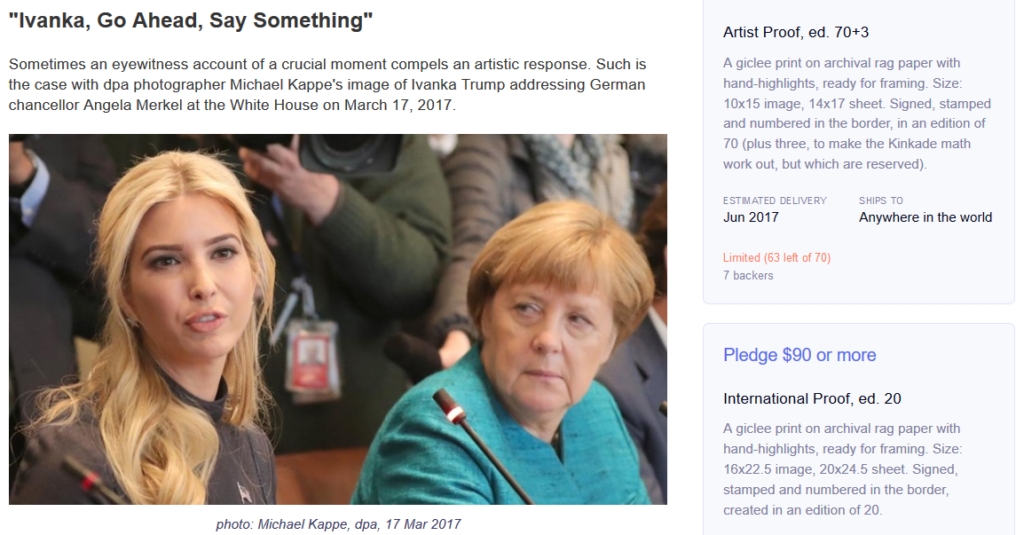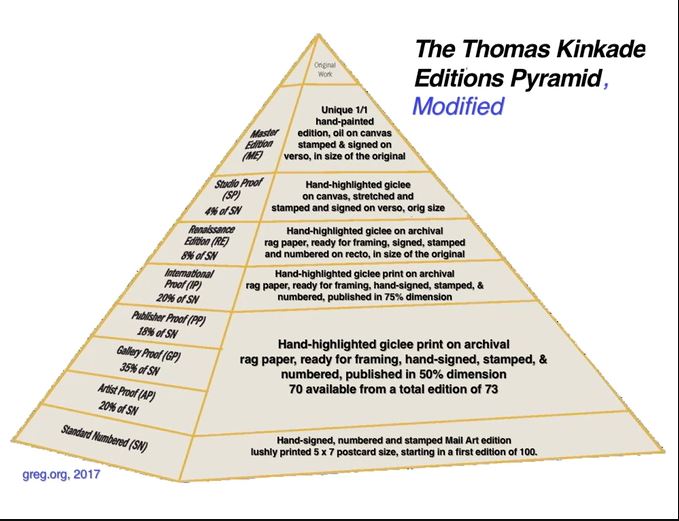Art World
What If George W. Bush Painted Ivanka? This Popular Kickstarter Project Dares to Dream
Greg Allen answers our questions about his project to make contemporary "history painting."

Greg Allen answers our questions about his project to make contemporary "history painting."

Brian Boucher

A new Kickstarter revives the hoary tradition of history painting with a project that brings together First Daughter Ivanka Trump and German Chancellor Angela Merkel, Pablo Picasso and anonymous Chinese painters-for-hire, into one neat conceptual package. While it’s at it, the campaign also draws inspiration from Thomas Kinkade, the much-mocked but wildly successful “Painter of Light,” and George W. Bush, the reviled 43rd president turned Sunday painter superstar.
Since we’re at a momentous time in history, Washington, DC-based filmmaker/writer Greg Allen, known for his funny, brainy, and insightful blog, asked himself a question: Who is the most fitting painter to depict this moment? His answer: Bush.
Figuring he couldn’t commission Dubya himself (nor would he want to, he says), Allen turned to artists who are a little more accessible: the so-called Chinese “paint mills,” where hacks turn around copies and commissions at a rapid pace (he has mined this terrain before). Their assignment: to create history paintings in Dubya’s style.
A particular moment captured Allen’s attention, a press agency’s photo of a March 17 White House roundtable attended by President Donald Trump’s daughter, Ivanka Trump. In a telling photo by Michael Kappe, visiting dignitary Angela Merkel seems to look on the First Daughter with disdain, giving her, as they say, the side eye.
Inspired by Kinkade’s tiered edition structure, Allen offers levels of pricing that correspond to what sizes and which level of “exclusive” product you get. (The top item, a “Master Edition” of the Bush/Trump themed canvas, is already sold at $1,200, but you still can get a variety of postcards and prints for prices ranging from $10 to $300.)

The “Thomas Kinkade Editions Pyramid, Modified” from Greg Allen’s “Our Guernica, After Our Picasso” Kickstarter.
The jokey Kickstarter is dubbed “Our Guernica, After Our Picasso,” and it claims to have a serious purpose: Allen draws inspiration from Picasso’s Guernica, which failed to stop the Second World War but went on to have larger symbolic impact in art history as a symbol of anti-war sentiment. “[T]his, perhaps, is painting’s job right now: to bear personal witness, to symbolize, to remind, and, when necessary, to shame.”
Unlike Picasso, however, who was paid by the Spanish Republic and in turn used his painting to raise funds for the Spanish Republican forces, Allen’s Kickstarter seems to be basically about raising money to commission the paintings themselves.
We talked to Allen about quickly reaching the project’s sales goals, what he calls its “[f]utility,” and how he works with his Chinese artists.
You’ve already more than doubled your $1,140 goal. How fast did that happen?
I met it during the first week. I set the goal low on purpose. So now the question is, should I even mention it anymore? I don’t want to beat it to the end. But people trickle in and keep buying.
The whole thing was done with the Thomas Kinkade pyramid in mind [in which the more buyers spend, the more exclusive versions of the work they get]. If there’s any immediate regret, it’s invoking Kinkade. But it works well with the Kickstarter structure. Now I’m down to the last week. I’m ending the Kickstarter on the 80th anniversary of the painting of Guernica. And I regret that too, though once I noticed that, it would be weird to end on the day before. The whole thing is actually very problematic.
You mention that you’ve commissioned a “skilled painter” in China, but offer no names. Are we talking about the kind of Chinese painting mill that has engaged your interest before? Or are we talking about, say, the Chinese painter who turned out to be the painter of the famous Knoedler forgeries?
It’s not the Knoedler forger, though that would be great. But no, it’s the painters in the mills, who mass-produce artworks, but this project, it turns out, is actually entirely different from what they actually do. They copy things you send them, but this is not copying, it’s creating. It’s taking a moment and producing it in a particular style, which requires quite a bit of interpretation.

Screenshot from Greg Allen’s Kickstarter.
So are you actually training the artists?
It’s just part of the process. I sent them a bunch of pictures of Bush paintings. And then I describe Bush’s style to them. They look at the paintings and see the pictures. I point out that it looks like there’s too much paint on the brush. They’re highly trained, but they’re trained to produce a photo accurately, not necessarily a painting.
How do you describe Bush’s skill to your Chinese artists?
They’re clearly brushy, painting wet-on-wet. He’s not afraid of a brush loaded with paint. He may not know what to do with it and he’s not going to let that stop him, but then that’s been characteristic of a lot of stuff he’s done. So he’s the painter of this time.
You clearly set out a parallel between the Spanish Civil War and the current administration: Nazi planes firebombed the Basque town of Guernica, and, though you didn’t mention this, the current administration has not only staged a deadly raid in Yemen and airstrikes in Syria, but also, both his critics and his supporters might maintain, thrown a bomb into the usual Washington procedures.
You know, I wasn’t necessarily thinking of Trump firebombing Washington, but I could see that as a possible interpretation. Guernica is one of those sacred cows of art. It’s like the Mona Lisa—we can’t really see it anymore. How did the painting get to that? It didn’t accomplish what it set out to do. It did not change the world for the better. Is the process of trying to capture something in a painting worth doing when there are bombs dropping and voters being deleted from databases? I don’t know.
So the project takes on a mournful tone.
At least let it fail. Then we’ll have an answer: “You shouldn’t have been doing this, idiot.” But then if it became the Guernica of its time, then what? I’m not going to make Guernica T-shirts. It could just kind of fade.
Are there more parallels to be drawn, in your eyes, between the fakery of the Chinese painting mills and Trump’s so-called post-truth scenario?
Yeah. I guess. Anyway, I appreciate people puzzling it out. That’s all you can hope for.